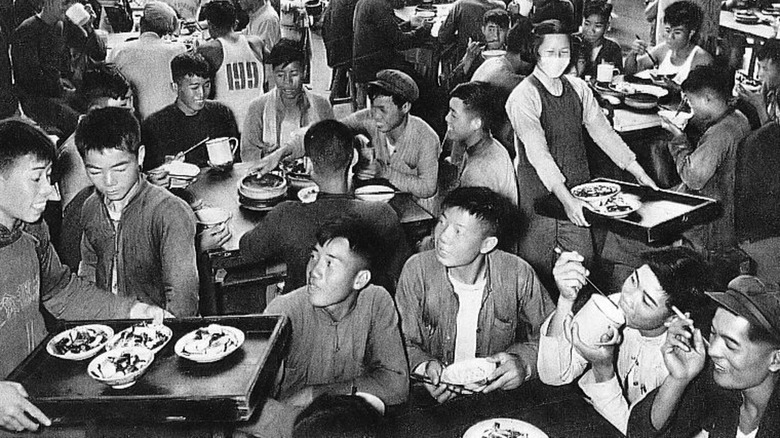Canteens' Troubling History In Communist China
The People's Republic of China was born from the Communist Party's victory in a civil war that raged from 1945 to 1949 (via Britannica). Chairman Mao Zedong rose to power with an ambitious vision for China's future, one centered on converting his country's predominantly agrarian economy into an industrialized powerhouse on the global stage. To this end, Mao launched an ambitious campaign called the Great Leap Forward in 1958. Per ThoughtCo., Mao wished to complete this nationwide industrial revolution in just five years. It sounds like an unrealistic goal, and ultimately, it was.
The Chinese Communist Party placed great value on the nation's rural farmers, a theme that continues even to this day under current leader Xi Jinping. Mao saw the immense potential in China's agrarian regions and developed the People's Commune system in an attempt to harness it. Atlas Obscura estimates that 99.1% of Chinese farmers were moved into communes by October 1958. According to Asia for Educators, there were at one point roughly 53,000 communes in China comprising 170,000 households and 90,000,000 acres of farmland. Every aspect of life in the communes was collectivized, including farming, manufacturing, schooling, and dining. Ultimately, Mao's grand five-year plan would be cut short by the drawbacks of this system, which contributed to one of the worst humanitarian crises in Chinese history.
The canteen system banned private kitchens
The People's Communes put a ban on all private property, including food. According to Atlas Obscura, all meals at the communes were distributed by communal canteens. They operated cafeteria style, with a bell signaling the start of each meal. Residents of the commune would line up for servings of rice, wheat buns, vegetables, and soup, with as many as 1,000 people dining at a single canteen. The food was free, but also mandatory, as the people were not allowed to prepare any food for themselves and farms had to send all of their crops to the canteens, giving the communal eateries a monopoly on the food supply.
As part of the ban on private dining, the government confiscated the people's cooking equipment. Private kitchens were destroyed and all the tools within them were used to establish the canteens. Initially, it seems that most people were happy to go along with this, and they rejoiced in the fact that everyone now had equal access to a bounty of food. However, this soon developed into a dangerously careless attitude. Historically, farmers had been careful about not exceeding their means, but believing that the government would always provide them with plenty, people began to eat more. When their eyes got too big for their stomachs, they would throw leftovers away, and food waste became a serious problem.
The Great Famine and the end of canteens
The canteen system came to an end amidst the devastating fallout from the Great Leap Forward, as Mao's plan backfired in multiple ways. ThoughtCo. notes that the plan to industrialize China had initially centered on establishing a local furnace at each commune to convert scrap metal into steel. However, locals were expected to meet a certain quota, regardless of how much scrap metal they had, so many people melted down valuable farming and kitchen equipment. Furthermore, the need to fuel the furnaces led to mass deforestation, causing widespread erosion that made the land poor for farming. When people could grow a surplus of crops, many ended up rotting in the fields because so many farmers had been sent to work in industrial fields.
These factors, combined with the food waste from canteens, triggered widespread starvation. In 1959, the Yellow River flooded, causing crops to fail, and the following year brought a devastating drought. This all led to the Great Famine, a humanitarian catastrophe that caused millions of deaths, according to NPR. Mao was forced to rescind some of his initiatives, and Atlas Obscura reports that the canteen system was fully phased out by 1962. However, in the 21st century, an interesting wave of nostalgia has popularized canteen-style restaurants where servers dress in communist uniforms. But this time, they are distinctly capitalist affairs.


